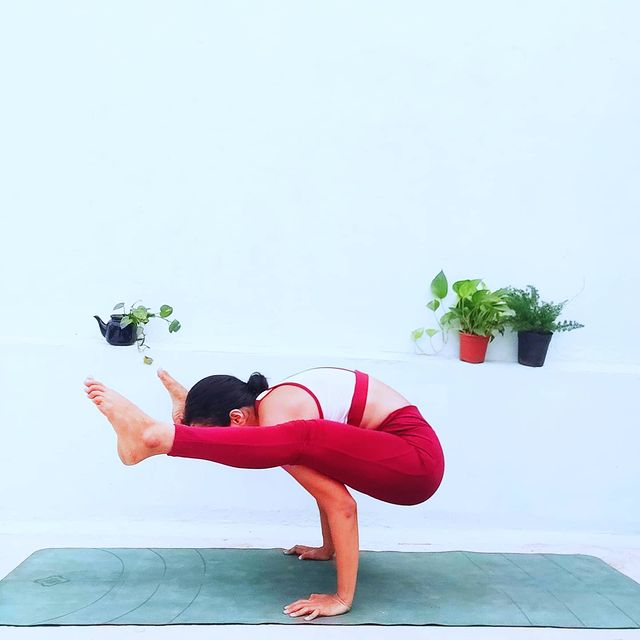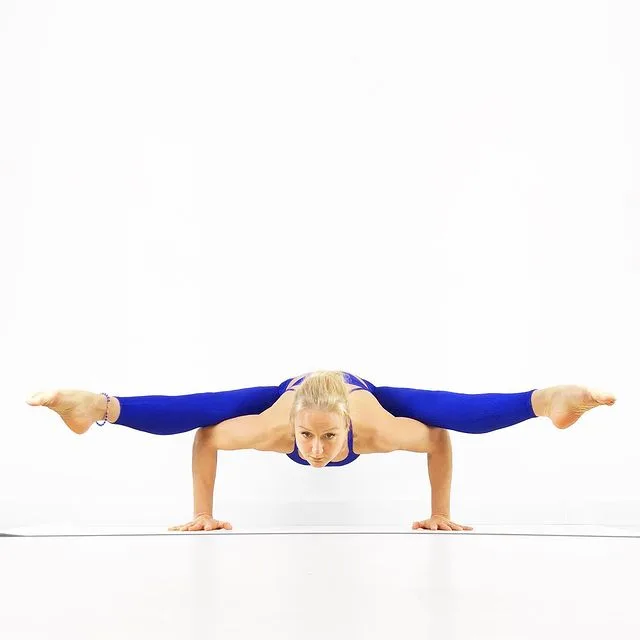Tittibhasana, also known as Firefly Pose, helps build strength in your arms and wrists while stretching your waist and back. It can also tone your stomach and increase your balance.
Information
| Known as: | Tittibhasana, Firefly Pose |
| Sanskrit name: | टिट्टिभासन |
| IAST: | Ṭiṭṭibhāsana |
| Pronunciation: | tit-tee-BHA-sah-nah |
| Level: | Advanced |
| Type: | Arm balance, forward bend |
| Total time: | 15 to 30 seconds |
| Drishti: | Forward; Bhrumadhye or Ajna Chakra (third eye, between the eyebrows); Nasagrai or Nasagre (nose) |
| Chakra: | Manipura Chakra |
| Focus: | Arm |
| Indications: | Anxiety, stress |
| Preparatory poses: | Uttanasana, Plank Pose, Four-Limbed Staff Pose, Garland Pose, Garudasana (Arms only), Crane Pose, Baddha Konasana, Prasarita Padottanasana, Upavistha Konasana, Tortoise Pose |
| Follow-up poses: | Standing Forward Bend Pose, Downward-Facing Dog Pose, Upward-Facing Dog Pose |
| Contraindications: | Wrist, elbow, shoulder and lower back injury, Pregnant women, Low blood pressure |
Meaning + Origin
The Tittibhasana is derived from the Sanskrit name, which is made up of two words — Tittibha + Asana:
- “Tittibha” = “firefly”
- “Asana” = “pose or posture”
Because in this yoga posture, the body is raised with only the hands on the floor, the pose mimics a firefly in flight, hence the name.
According to Hindu legends, Tittibha birds lay their eggs along the beach. But the ocean, which has immense power, carried away his eggs. On this the Tittibha birds complained to the Ocean God(Lord Vishnu) and Vishnu ordered the sea to return its eggs.
In Tittibhasana, Tittibha, a small flying insect, represents a yogi’s efforts to overcome the illusion created by the mind. The sea is the metaphor used for the mind in this story. Like the ocean, our mind also gets confused due to power and the ignorant, but with efforts the yogi can overcome it.
Benefits of Tittibhasana (Firefly Pose)
Tittibhasana is the arm balancing posture that demands strength and tenacity.
In meditation, Tittibhasana activates the solar plexus chakra, Manipura Chakra. Located at the navel, this chakra is associated with self-control, self-confidence, emotional balance and contentment. Practitioners who activate this chakra through Firefly Pose will strengthen their sense of self and gain better control over their emotions.
However, the physical and mental benefits of Tittibhasana (Firefly Pose) are listed below:
- Physical Benefits:
- Strengthens the muscles of shoulders, arms, and wrists.
- Stretches groins and enhances flexibility, relieves pain in groins, and improves leg mobility.
- The effect is similar to Yoganidrasana, but in this pose the thighs are stretched more, and more tension is felt on the neck, spine and the sacrolumbar region of the abdomen.
- The lungs and abdominal muscles contract the most in this asana, tonnes abdominal and hence, also beneficial in burning belly fat.
- The spinal cord is given full stretch forward and the digestive organs and improves digestion by the exercise.
- Improves the balance.
- Mental Benefits:
- Relieves stress
- Promotes sense of balance
- Calms the mind
Tittibhasana (Firefly Pose) Practice Guide
In Tittibhasana (Firefly Pose), both the hips are flexed and the knees are extended. The inner legs press against the arms, connecting the upper and lower extremities and tying the elbows. Engagement of the inner thighs and upper arms draws strength from the core of the pelvis and shoulder girdle for balance in the pose.
Tittibhasana (Firefly Pose) is a symmetrical pose that moves the center of gravity forward from Crow or Crane Pose. Forward extension through the legs is constrained backward by the outward push of the arms against the thighs, there is also an upward lift of the torso against the downward pull of gravity. Fine adjustments can be made by flexing and spreading the ankles. For example, pointing the feet projects the center of gravity forward. Feel how this affects the distribution of weight in the arms. Simultaneously flex the hips and torso. This action bends the legs upwards. Link it by squeezing the thighs into the arms.
The pose is an advanced posture. Before practicing Kurmasana, or Tortoise Pose, you must be proficient in practicing it, as it requires significant flexibility in the back and hamstrings. See the Easy Stretch article on Kurmasana or Tortoise Pose for tips. Additionally, you should be comfortable doing Crane (Crow) Pose and Chaturanga Dandasana (Four-Limbed Staff pose) to ensure adequate arm strength and balance for Tittibhasana (Firefly Pose).
Step-by-step instructions to Tittibhasana

Instructions
- Begin squatting with the feet slightly less than shoulder width apart. Tilt your abs forward and lower your torso to hang between your legs. Keeping your body down, bend your legs until your abs are about equal to your knees.
- Bring your left upper arm and shoulder under your left thigh above your knee, placing your hand on the outside of your leg. Your fingers should be facing forward. Do the same with the right upper arm.
- Lift your body off the ground, shifting your center of gravity. Press your hands into the ground and gently roll your weight from your feet to your hands. Keep your inner thighs as high as you can with your arms.
- While inhaling, while keeping your stomach high, spread your legs as far to the side as possible, so that your feet are parallel to the ground. Push through the bottom of your big toes while pulling and extending your toes toward your body. Keeping the outer edges behind, bend the inner edges of your feet slightly forward.
- Straighten your arms and widen your shoulder blades to hollow out your chest. Raise the head and look into the distance. Take slow breaths and stay in this position for 15–30 seconds. Then while exhaling, drop your feet on the ground.
Beginners tip
Beginners can make this pose easier by sitting on the ground, keeping your feet at a 90-degree angle, and using a yoga block to lift each heel.
Step-by-step Anatomy Engaging Techniques
Step-1
- Engage your humeri and draw your forearms perpendicular to the floor; Spread (abduct) your shoulder blades. These actions result from firmly engaging your pectoralis major, teres major, latissimus dorsi, long head of your triceps (see Step-2), and coracobrachialis muscles.
- If you press your hand into the wall and try to pull your arm across your body, you can feel these muscles being activated with the other hand.
- Together with your pectoralis major and minor, your serratus anterior protrudes the shoulder blades and draws them away from the midline.
Step-2
- Engage your pronator teres and quadratus by pressing your hands into the mat.
- Spread the weight evenly over your palms, using your flexors carpi radialis and ulnaris to flex your wrists.
- Raise your arms by engaging your triceps to extend your elbows and stabilize your shoulders.
- Press your body upward by activating your anterior and lateral deltoids.
- Finally, rotate your shoulders outward. Remember that your deltoids are divided into three segments.
- Use your anterior section to raise your torso, and use your lateral section to press the arms out against your knees.
- Contract your infraspinatus and teres minor muscles to externally rotate your upper arms; This stabilizes your elbows and prevents them from rotating outwards.
- To aid in this action, contract the posterior third of your deltoids eccentrically.
Step-3
Engage your psoas to flex your hips at the pelvis and lift your legs into the air from your pelvic core. To coordinate this action, contract your pectineus and adductors longus and brevis and squeeze your legs into the arms. Activate your abdominals to pull your pubic symphysis upward; It feels like pulling in from your lower abdomen, below the navel. Engagement of your abdominals reciprocally inhibits your erector spinae and other back muscles, allowing them to lengthen in the stretch.
Step-4
Contract your adductor group of muscles to press your thighs into the upper arms. Because your adductor magnus is also a hip extensor, many of its fibers will stretch in Firefly Pose (Tittibhasana).
Step-5
Straighten your knees by engaging your quadriceps. This creates a reciprocal inhibition of your hamstrings, allowing them to relax in the stretch. Your rectus femoris crosses your hip joint (it is polyarticular) and thus coordinates your psoas muscle to flex your hips. Your gluteus minimus and tensor fascia lata muscles also flex and internally rotate your femur in this position, counteracting the tendency of the stretching gluteus maximus to externally rotate your thighs.
Precautions and contraindications
- This pose is difficult to balance, so there is a possibility of being out of posture. So, use props or supports and find an open space to practice Firefly Pose where you don’t get hurt even if you fall.
- Do not do this while you are recovering from surgery.
- You should avoid this pose if you are suffering from shoulder, wrist, elbow or lower back injuries.
- Pregnant women should not practice this yoga asana.
- Individuals with low blood pressure should avoid this yoga pose.















